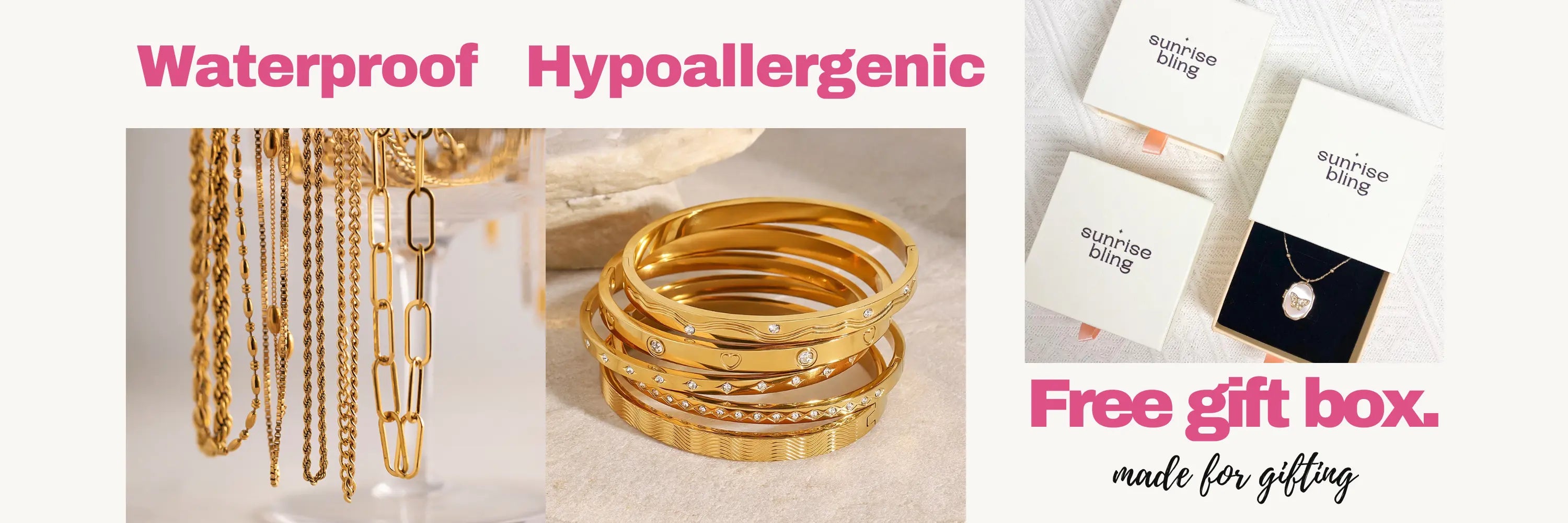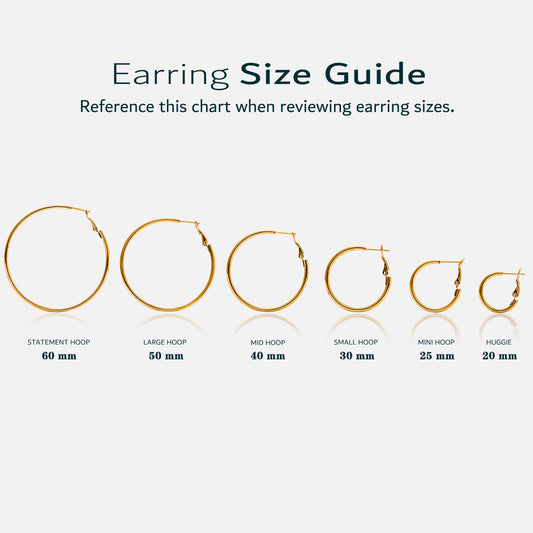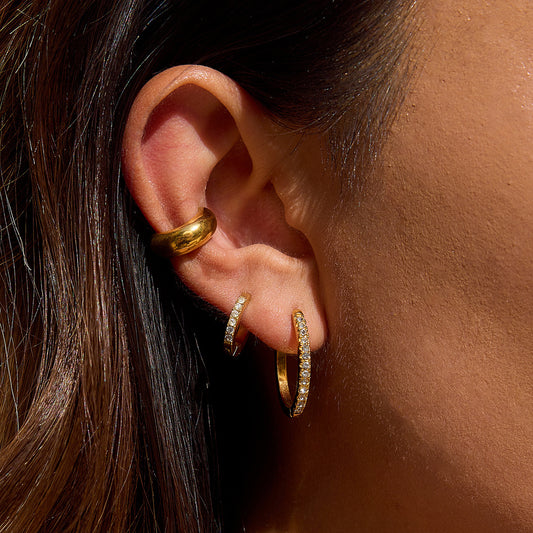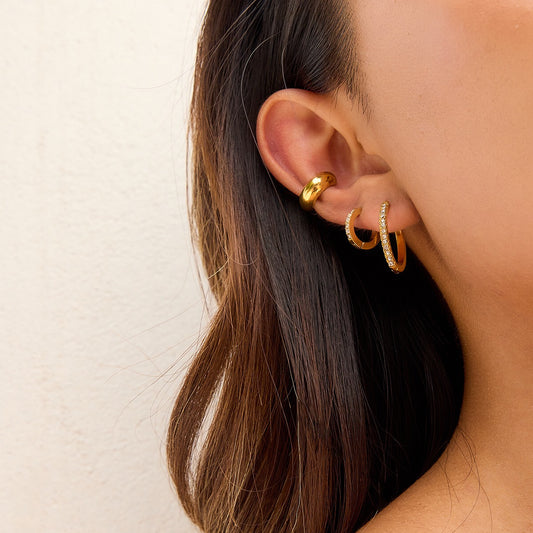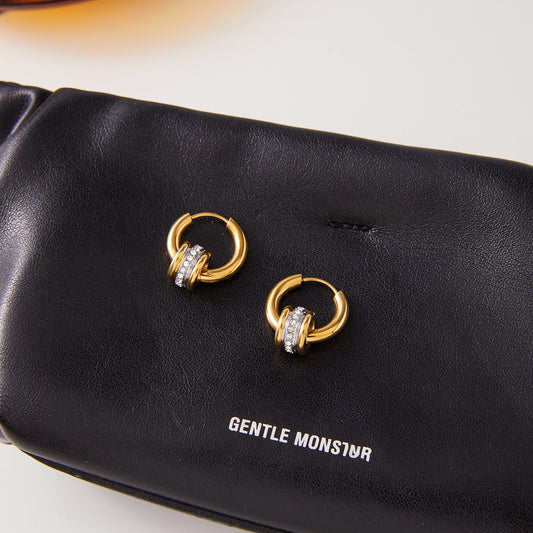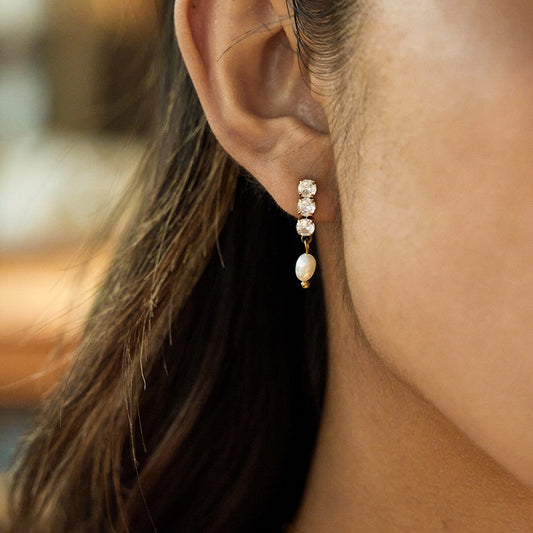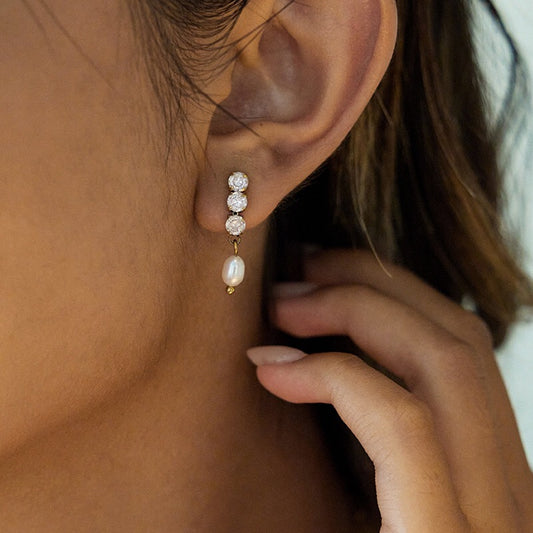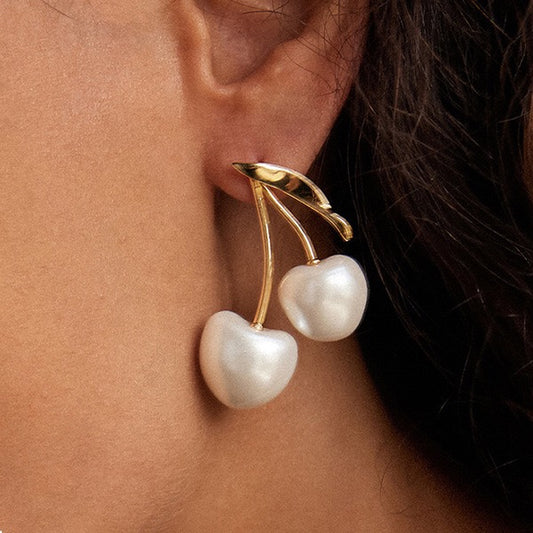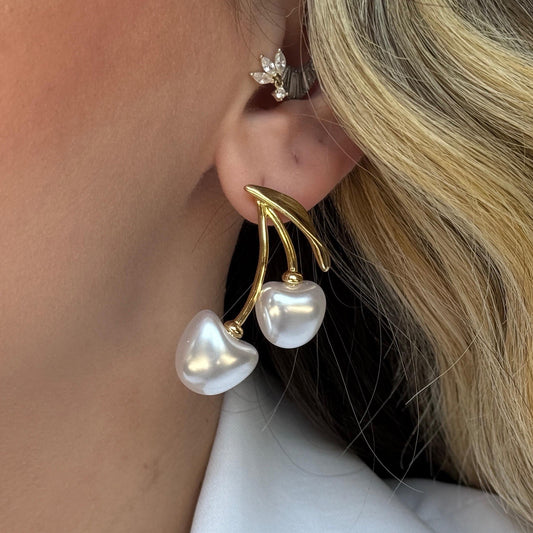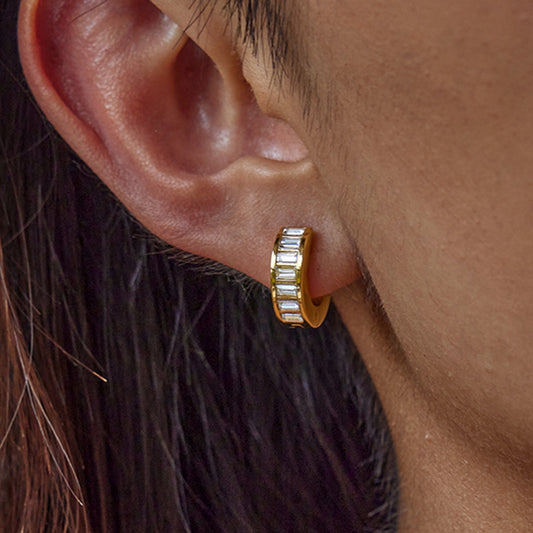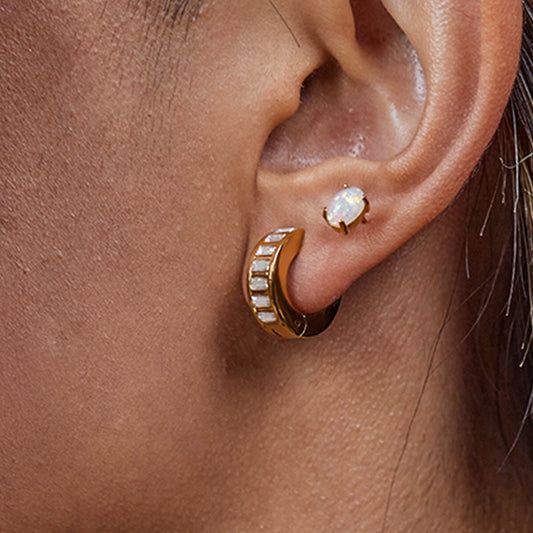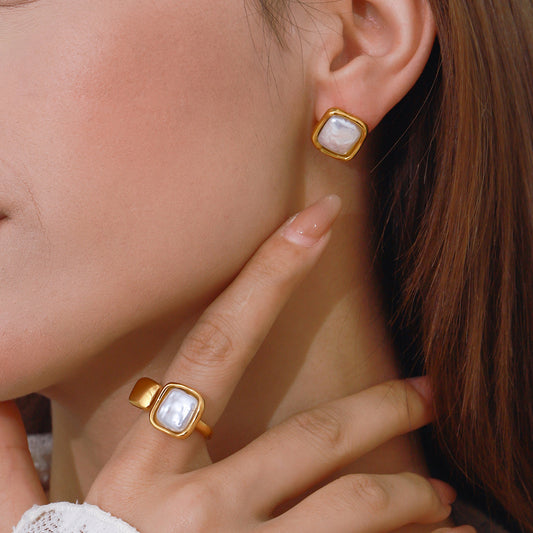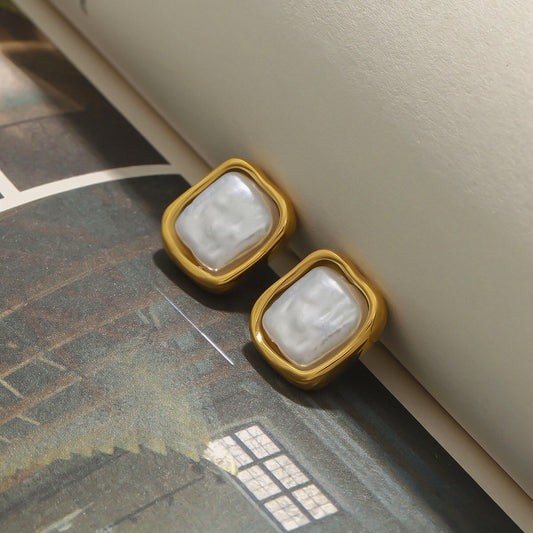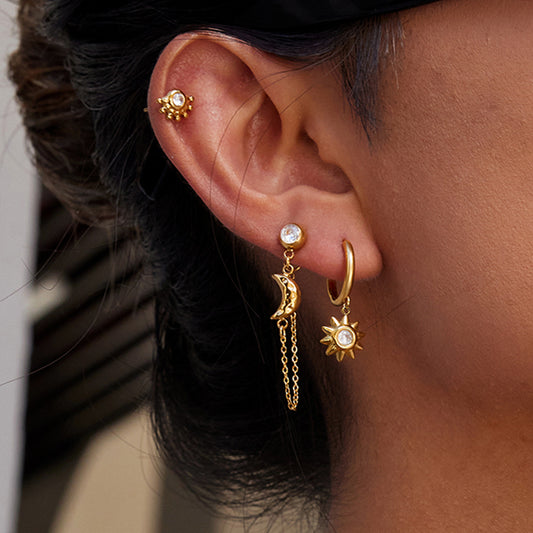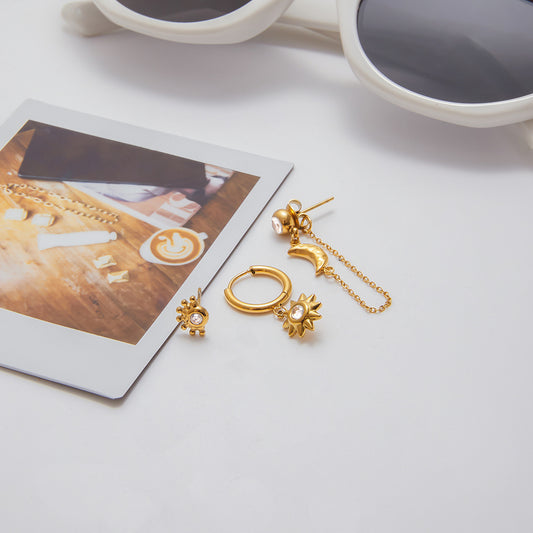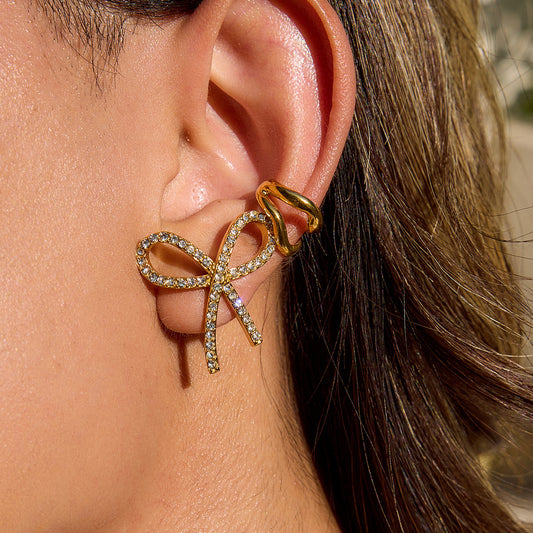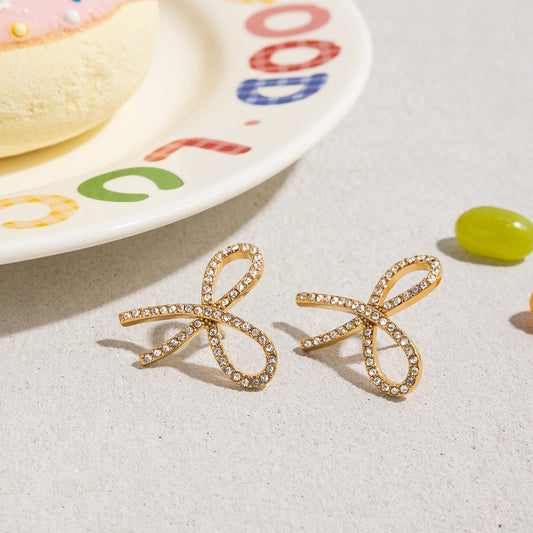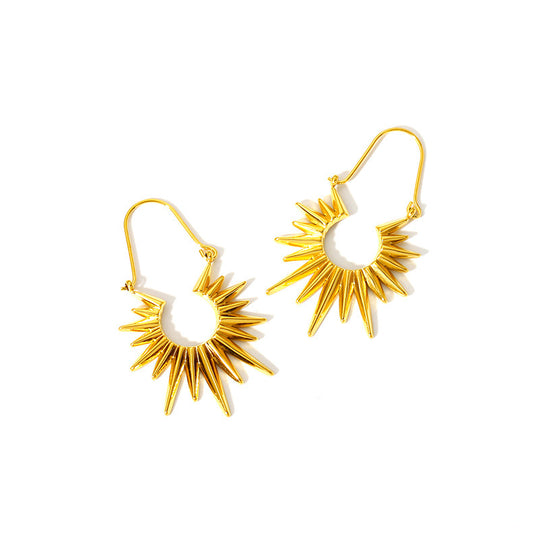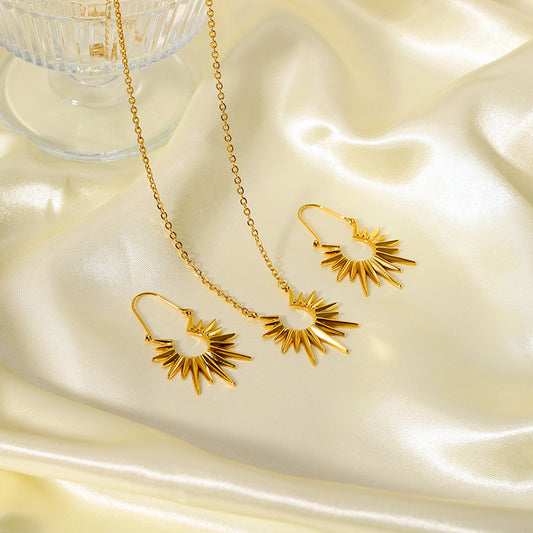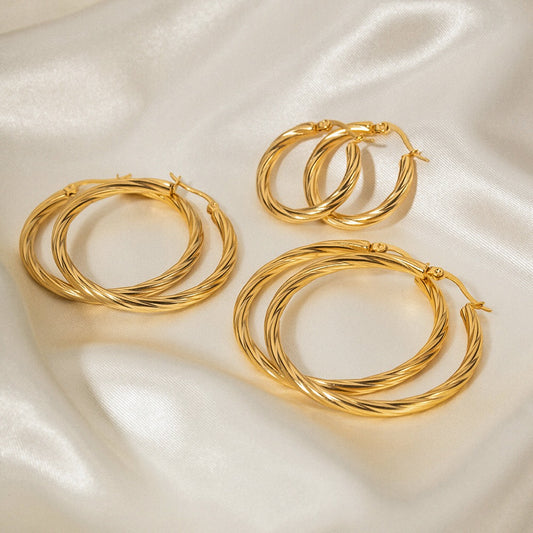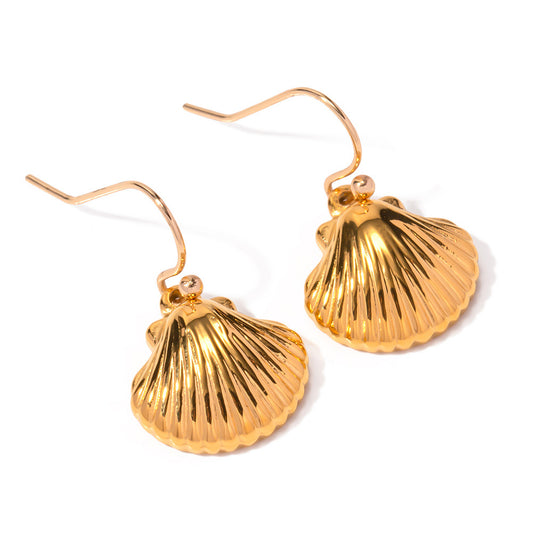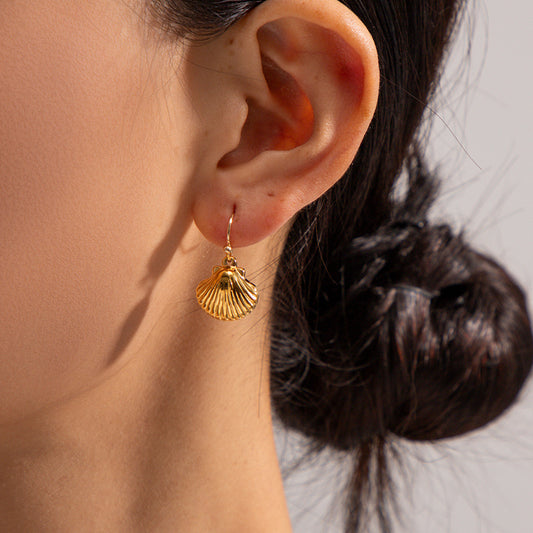Cartilage earrings have become a defining trend in ear jewelry, transforming simple ear stacks into bold, personalized statements—and their popularity shows no signs of slowing. The global jewelry market size was estimated at USD 366.79 billion in 2024 and is projected to reach USD 578.45 billion by 2033. What makes them so beloved? Unlike lobe earrings (which feel classic), cartilage earrings add an edgy, modern twist—whether you’re rocking a tiny stud in your helix or a dainty hoop in your conch. They’re versatile enough for everyday wear (think: work meetings or coffee runs) and bold enough for nights out, making them a must-have for anyone looking to elevate their ear game. This guide covers everything you need to know about cartilage earrings, from their design to where to buy the best pairs for your piercings.

What Are Cartilage Earrings?
Cartilage earrings are specialized jewelry designed to fit and protect cartilage piercings—ear piercings that go through the tough, flexible cartilage of the ear (not the soft lobe). Unlike lobe earrings (which use standard posts or hoops), cartilage earrings are crafted with shorter posts, thicker gauges, or secure closures to prevent irritation, infection, or damage to the delicate cartilage. They come in a range of styles, from minimalist studs to intricate hoops, and are made with hypoallergenic materials to minimize discomfort for new or sensitive piercings.

Key Characteristics of Cartilage Earrings
-
Gauge Size: The “gauge” (thickness of the post/wire) is critical for cartilage piercings, which are typically pierced at a thicker gauge than lobes:
-
Standard Cartilage Gauge: 16g (1.2mm) or 14g (1.6mm)—thicker than lobe piercings (usually 20g or 18g). Thicker gauges reduce the risk of the post bending or tearing cartilage.
-
Avoid Thin Gauges: Never use 18g or smaller earrings in cartilage piercings—they’re too thin and can cause the piercing to stretch or heal incorrectly.
-
Post Length: Cartilage earrings have shorter posts (6–8mm) than lobe earrings (10–12mm) to fit the smaller, tighter space of cartilage. Longer posts can rub against the skull or get caught on clothing, leading to irritation.
-
Closure Types: Secure closures prevent earrings from falling out and protect the piercing:
-
Flat Backs (Labrets): The most popular— a flat disc on one end and a threaded or push-in closure on the other. They lie flush against the cartilage, reducing irritation from clothing or hair.
-
Captive Bead Rings (CBRs): A circular hoop with a small bead held in place by tension. Ideal for conch or helix piercings but require careful handling to avoid losing the bead.
-
Hinged Hoops: Small hoops with a hinged closure that snaps shut. Easy to put on/take off and secure enough for daily wear.
-
Hypoallergenic Materials: Cartilage is more sensitive than lobes, so earrings use materials that reduce irritation:
-
Surgical Steel: Affordable and hypoallergenic—ideal for new piercings or sensitive skin.
-
Titanium: Lightweight and nickel-free—great for those with severe metal sensitivities.
-
14k Gold: Luxurious and durable—safe for healed piercings (avoid for new piercings, as gold can contain trace nickel).

How Cartilage Earrings Differ from Lobe Earrings
-
Design for Safety: Cartilage earrings prioritize protection—shorter posts, thicker gauges, and flat backs prevent damage to cartilage, while lobe earrings focus on style (longer posts, thinner gauges, decorative closures).
-
Material Requirements: Cartilage earrings need hypoallergenic materials to avoid infection, while lobe earrings can use cheaper metals (like brass or plated steel) for healed lobes.
-
Healing Compatibility: New cartilage piercings take 6–12 months to heal (vs. 6–8 weeks for lobes), so cartilage earrings are designed to be worn long-term without causing irritation—lobe earrings can be swapped more frequently.
Why Are Cartilage Earrings So Popular?
Cartilage earrings have exploded in popularity because they blend individuality, versatility, and trendiness—appealing to everyone from teens to adults. Below are the key reasons they’ve become a staple in ear jewelry:
Edgy Personalization for Ear Stacks
Ear stacking (wearing multiple earrings in one ear) is one of the biggest jewelry trends, and cartilage earrings are the star of the look. They let you mix and match styles: a tiny stud in your helix, a hoop in your conch, and a chain earring connecting them—creating a unique “earscape” that reflects your personality. Unlike lobe earrings (which can feel uniform), cartilage earrings add depth and edge, making your ear stack stand out.
Versatility for Every Style & Occasion
Cartilage earrings adapt to any vibe, from casual to formal:
-
Casual: A minimalist surgical steel flat back in your helix pairs with a t-shirt, jeans, and sneakers—subtle edge without being over-the-top.
-
Work: A small 14k gold hinged hoop in your tragus complements a blazer and button-down—polished enough for meetings, yet trendy.
-
Formal: A cartilage earring with a tiny cubic zirconia (in a flat back style) elevates a cocktail dress or gown—adds sparkle without clashing with other jewelry.

Accessibility for All Piercing Types
Cartilage earrings are designed for every cartilage piercing, making them inclusive for anyone with (or planning to get) a cartilage piercing:
-
Helix: The most common—outer ear cartilage. Works with studs, hoops, or chain earrings.
-
Conch: Inner ear cartilage (shaped like a conch shell). Ideal for hoops or large studs.
-
Tragus: Small, hard cartilage flap in front of the ear canal. Best for tiny studs or thin hoops.
-
Daith: Curved cartilage fold near the ear canal. Uses small hoops or captive bead rings.
This variety means you can find a cartilage earring for any piercing, whether you’re starting small or building a full ear stack.
Affordability for Trend Experimentation
Cartilage earrings are available at every price point, making it easy to try the trend without overspending:
-
Surgical steel or titanium studs start at \(15–\)30.
-
Gold-plated or silver hoops range from \(30–\)80.
-
14k gold or gemstone-accented earrings cost \(80–\)200+.
This affordability lets you swap styles seasonally (e.g., pastels in spring, metallics in winter) or add to your collection gradually.
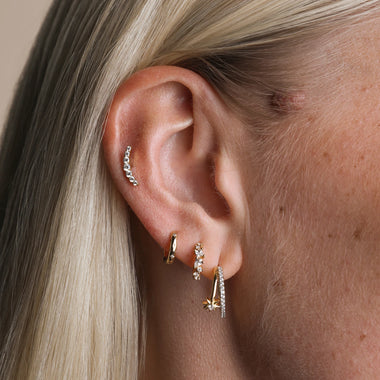
Popular Styles of Cartilage Earrings
Cartilage earrings come in endless designs, from minimalist to bold, ensuring there’s a style for every piercing and taste. Below are the most in-demand options:
Minimalist Cartilage Studs (Everyday Essential)
Tiny, sleek studs that add subtle edge—perfect for new piercings or anyone who prefers understated style:
-
Surgical Steel Flat Back Studs: A small (3–4mm) round or square top in surgical steel with a flat back. The most popular choice for helix or tragus piercings—hypoallergenic and easy to wear daily.
-
Titanium Micro Studs: Even smaller (2–3mm) studs in titanium, ideal for daith or upper helix piercings. Available in matte or polished finishes for a subtle texture.
-
14k Gold Dot Studs: A tiny gold dot (3mm) on a flat back—luxurious enough for work or dates, and pairs beautifully with other gold earrings.
Cartilage Hoops (Bold & Versatile)
Hoops add a playful, edgy touch—great for healed helix, conch, or tragus piercings:
-
Hinged Cartilage Hoops: Thin (1mm) hoops (8–10mm diameter) with a hinged closure. Made of surgical steel or titanium, they’re easy to put on and secure enough for daily wear. Available in silver, gold, or black.
-
Captive Bead Rings (CBRs): Circular hoops (10–12mm diameter) with a small bead held in place by tension. Ideal for conch piercings—add a pop of color by choosing a bead in a bright hue (e.g., blue, pink).
-
Clicker Hoops: Similar to hinged hoops but with a “click” closure that snaps shut. They lie flat against the cartilage and come in intricate designs (e.g., twisted metal, tiny gemstones) for extra style.
Gemstone Cartilage Earrings (Sparkly & Sentimental)
Gemstone accents add sparkle and meaning—perfect for gifting or celebrating milestones:
-
Cubic Zirconia Flat Backs: A small (3–4mm) cubic zirconia (CZ) in a prong setting on a surgical steel or titanium flat back. The CZ mimics diamond sparkle, making it a budget-friendly way to add glamour.
-
Birthstone Cartilage Studs: A tiny birthstone (e.g., garnet for January, amethyst for February) in a bezel setting. Choose your own birthstone, your girlfriend’s, or a stone that matches your style.
-
Colored Gemstone Hoops: Thin hoops with small colored gemstones (e.g., turquoise, ruby) set at intervals. The gemstones add a pop of color without being too flashy—great for summer.
Chain Cartilage Earrings (Edgy & Connected)
Chain earrings connect two piercings (e.g., helix and lobe) for a cohesive, bold look—ideal for ear stack lovers:
-
Helix-to-Lobe Chain: A thin chain (1–2mm) with a small stud on one end (for the helix) and a lobe earring on the other. Available in silver or gold, it adds movement and edge to your ear stack.
-
Double Cartilage Chain: A chain connecting two cartilage piercings (e.g., upper and lower helix). The delicate chain creates a “connected” look without overwhelming the ear.
How to Wear Cartilage Earrings
Wearing cartilage earrings is all about balancing edge with cohesion—whether you’re rocking one piece or a full ear stack. Below are tips for styling them for different looks and piercings:
Styling for Casual Looks
-
Single Minimalist Stud: Wear a surgical steel flat back stud in your helix with a graphic tee, high-waisted jeans, and white sneakers. Keep other earrings simple (small lobe studs) to let the cartilage earring add subtle edge.
-
Hinge Hoop + Lobe Stack: Pair a small gold hinged hoop in your conch with 2–3 thin lobe studs (matching gold). Add a denim jacket and canvas sneakers for a cool, effortless vibe.
-
Chain Earring + Casual Dress: A helix-to-lobe chain earring pairs with a flowy sundress and sandals. The chain adds movement, and the dress softens the edgy look—perfect for brunch or a day out.
Styling for Work Wear
-
Tiny Gold Stud: A 14k gold dot stud in your tragus complements a blazer, button-down shirt, and tailored trousers. It’s subtle enough for meetings but still feels trendy.
-
Surgical Steel Clicker Hoop: A small silver clicker hoop in your helix works with a knit sweater, wide-leg pants, and loafers. The polished silver pairs with both silver and gold accessories, making it versatile.
-
Neutral Gemstone Stud: A clear CZ or white topaz cartilage stud in your conch adds subtle sparkle to a work outfit. It’s professional enough for client calls but still feels like a personal touch.
Styling for Formal Occasions
-
Gemstone Cartilage Stud + Lobe Hoops: A cubic zirconia flat back stud in your helix with small gold lobe hoops pairs with a floor-length gown. The sparkle catches light under formal lighting, and the gold ties the look together.
-
Gold Chain Earring + Cocktail Dress: A helix-to-lobe gold chain earring complements a knee-length cocktail dress and strappy heels. It’s bold enough to stand out but not too flashy for formal events.
-
Platinum Cartilage Hoop: A thin platinum hinged hoop in your conch pairs with a tailored tuxedo or silk camisole and trousers. The platinum adds luxury without competing with other jewelry (e.g., a simple necklace).
Styling by Piercing Type
-
Helix: Use studs or small hoops—avoid large styles that can rub against the skull. Pair with lobe earrings for balance.
-
Conch: Opt for larger hoops or statement studs— the conch has more space, so you can go bolder.
-
Tragus: Stick to tiny studs or thin hoops— the tragus is small, so large earrings can feel overwhelming.
-
Daith: Use small captive bead rings or clicker hoops— the curved shape of the daith works best with circular styles.
Cartilage Earrings: Perfect Gift for Your Girlfriend
Cartilage earrings make a thoughtful, trendy gift for your girlfriend—they show you pay attention to her style (whether she loves minimalist or bold jewelry) and support her love for personalized ear stacks. Unlike generic gifts, a cartilage earring is a piece she’ll wear daily, reminding her of you every time she adjusts her ear jewelry.
Why It Resonates as a Girlfriend Gift
-
Personalization: You can choose a style that fits her taste—minimalist gold for the subtle dresser, gemstone for the sparkle lover, or chain for the edgy fashionista.
-
Thoughtfulness: Gifting a cartilage earring means you notice her piercings (or her desire to get one)—it’s a small detail that shows you care about her interests.
-
Versatility: She’ll wear it with nearly every outfit, from casual to formal—unlike a dress or bag that’s only used occasionally.
Top Cartilage Earring Gifts for Your Girlfriend
-
14k Gold Flat Back Stud: A tiny gold dot or CZ flat back stud—luxurious enough for special occasions, but simple enough for everyday wear. Perfect for birthdays or anniversaries.
-
Birthstone Cartilage Hoop: A small hinged hoop with her birthstone set into the metal. It’s personal and trendy—great for Valentine’s Day or “just because” gifts.
-
Gold Chain Earring: A helix-to-lobe gold chain earring if she has multiple piercings. It elevates her ear stack and feels like a “treat yourself” piece she might not buy for herself.
Tips for Choosing the Right One
-
Check Her Piercings: Know which cartilage piercings she has (helix, conch, etc.)—a hoop won’t work for a tragus, and a tiny stud might be too small for a conch.
-
Match Her Style: If she wears mostly gold, choose gold; if she loves silver, stick to surgical steel or titanium. If she’s minimalist, avoid overly bold designs.
-
Consider Healing Status: If her cartilage piercing is new (less than 6 months old), gift hypoallergenic materials (surgical steel, titanium)—never gold or plated metals, which can cause irritation.
How to Clean Cartilage Earrings
Cleaning cartilage earrings is critical—cartilage piercings are prone to infection if dirt, oil, or bacteria build up. The process is simple but requires consistency, especially for new piercings.
Daily Cleaning for New Piercings (Healing Phase: 6–12 Months)
New cartilage piercings need gentle, frequent cleaning to prevent infection:
-
Gather Supplies: Use a saline solution (0.9% sodium chloride)—you can buy pre-made piercing saline (e.g., NeilMed Piercing Aftercare) or mix your own (1/4 teaspoon sea salt + 1 cup warm distilled water).
-
Clean the Piercing: Soak a clean cotton ball or gauze in saline and hold it against the piercing for 3–5 minutes (both front and back). This loosens crusties (dried lymph fluid) and kills bacteria.
-
Rinse Gently: Use a saline spray to rinse away any remaining crusties—avoid rubbing or twisting the earring, as this can irritate the healing tissue.
-
Dry Thoroughly: Pat the area with a clean, dry paper towel or disposable cloth—never use a regular towel, which can harbor bacteria.
Weekly Deep Cleaning for Healed Piercings
Once your piercing is fully healed (no redness, swelling, or pain), deep clean the earring every week:
-
Remove the Earring: Only remove fully healed earrings—never take out new piercings (they can close quickly).
-
Soak in Saline or Mild Soap: Let the earring soak in saline solution or a mix of warm water + 1 drop mild dish soap (Dawn) for 10 minutes.
-
Scrub Gently: Use a soft-bristled toothbrush (designated for jewelry) to scrub the post, closure, and any gemstones—focus on crevices where dirt builds up.
-
Rinse and Dry: Rinse the earring under warm water, then dry it with a clean microfiber cloth before reinserting.
What to Avoid When Cleaning
-
Alcohol or Hydrogen Peroxide: These are too harsh—they kill healthy tissue and slow healing.
-
Q-Tips: The cotton fibers can get stuck in the piercing or irritate the cartilage. Use gauze or cotton balls instead.
-
Twisting or Rotating the Earring: For new piercings, twisting the earring can disrupt the healing tissue and increase the risk of infection. Only adjust or reposition fully healed earrings.
-
Sharing Earrings: Never share cartilage earrings—this spreads bacteria and can lead to infections like staph or piercing bumps.
Where to Buy Cartilage Earrings
Choosing the right place to buy cartilage earrings is key—you need retailers that prioritize safety (hypoallergenic materials, proper sizing) and style (trendy, high-quality designs). Below are the most reliable options, categorized by shopping preference:
Online Retailers (Convenient & Specialized)
Online stores offer the widest selection of cartilage earrings, with detailed product descriptions and customer reviews to help you choose:
-
Body Candy: A leading body jewelry retailer with a huge range of cartilage earrings—from surgical steel flat backs (\(15–\)30) to 14k gold gemstone hoops (\(80–\)150). They list gauge and post length clearly, making it easy to find the right fit. They also offer free shipping on orders over $25 and a 30-day return policy.
-
Pierced Universe: Specializes in piercing-safe jewelry, so all cartilage earrings are made with hypoallergenic materials (titanium, surgical steel, 14k gold). They have a “Cartilage Collection” organized by piercing type (helix, conch, tragus), with prices ranging from \(20–\)200+. They also provide a “Gauge Guide” for beginners.
-
Etsy: Great for unique, handmade cartilage earrings—think custom birthstone studs or handcrafted chain earrings. Most sellers list materials and sizing details, and you can message them for custom requests (e.g., a specific gold color or gemstone). Prices start at \(15 for simple studs and go up to \)100+ for artisanal designs.
In-Store Retailers (Hands-On Shopping)
In-store shopping lets you see and feel the earrings, and get expert advice from piercers—ideal for new piercings or if you’re unsure about sizing:
-
Professional Piercing Studios: The safest option for cartilage earrings—studios only sell jewelry that’s piercing-safe (no cheap plated metals) and sized correctly. Piercers can measure your piercing and recommend styles (e.g., flat backs for new helix piercings). Chains like Claire’s (Professional Piercing Section) or local independent studios offer earrings from \(20–\)100.
-
Jewelry Stores (Fine Jewelry): Stores like Kay Jewelers or Zales sell 14k gold or platinum cartilage earrings—great for luxury styles (e.g., diamond-accented studs). Prices range from \(100–\)500+, and they often have sales during holidays. Staff can help you choose earrings that match your existing jewelry.
-
Fashion Retailers: Stores like Urban Outfitters or H&M sell affordable fashion cartilage earrings (gold-plated, beaded styles) for \(10–\)30. These are best for fully healed piercings—avoid them for new piercings, as the materials may not be hypoallergenic.
Luxury Retailers (High-End Designs)
For investment pieces or special gifts, luxury retailers offer high-quality cartilage earrings in precious metals and gemstones:
-
Tiffany & Co.: Their “Tiffany HardWear” collection includes 18k gold cartilage hoops and studs—sleek, modern designs that are perfect for formal occasions. Prices start at \(500 and go up to \)2,000+.
-
Mejuri: Known for minimalist fine jewelry, Mejuri sells 14k gold cartilage flat backs and hoops—simple, timeless styles that work for everyday wear. Prices range from \(150–\)400, and they offer free shipping and a 30-day return policy.
What Earrings Are Best for Cartilage Piercings?
Not all earrings work for cartilage piercings—choosing the right style depends on your piercing type, healing status, and personal preference. Below is a breakdown of the best earrings for each scenario:
Best Earrings for New Cartilage Piercings (Healing Phase)
New piercings (0–12 months old) need earrings that prioritize safety and comfort to prevent infection and irritation:
-
Material: Must be hypoallergenic—surgical steel (316L), titanium (grade 23), or niobium. Avoid gold (even 14k), plated metals, or brass—these can contain nickel or irritate healing tissue.
-
Style: Flat backs (labrets) are the best—they lie flush against the cartilage, reducing friction from clothing or hair. Avoid hoops, chains, or dangly styles—they can get caught and pull the piercing.
-
Gauge/Size: Match the gauge your piercer used (usually 16g or 14g). The post length should be 6–8mm—long enough to accommodate swelling but not so long that it rubs against your skull.
Best Earrings for Healed Cartilage Piercings
Once your piercing is fully healed (no redness, swelling, or pain), you can experiment with more styles:
-
Helix Piercings: Flat backs, small hinged hoops (8–10mm), or tiny chain earrings. Avoid large hoops (over 12mm)—they can rub against the skull and cause discomfort.
-
Conch Piercings: Larger hoops (10–14mm), statement flat backs (with gemstones or designs), or captive bead rings. The conch has more space, so you can go bolder with size and style.
-
Tragus Piercings: Tiny flat backs (3–4mm) or thin hinged hoops (6–8mm). The tragus is small and close to the ear canal, so large earrings can block sound or feel overwhelming.
-
Daith Piercings: Small captive bead rings (8–10mm) or clicker hoops. The curved shape of the daith requires circular earrings—flat backs will not fit correctly.
Best Earrings for Sensitive Skin
If you have sensitive skin (prone to redness or itching), choose earrings that are 100% nickel-free:
-
Titanium: The most hypoallergenic option—lightweight and non-reactive, even for severe sensitivities.
-
Niobium: Similar to titanium but slightly more affordable—great for those with metal allergies.
-
14k Gold (Nickel-Free): Look for gold labeled “nickel-free”—most luxury brands offer this. Avoid 10k gold, which contains more nickel.
Frequently Asked Questions About Cartilage Earrings
Q: Can I wear regular lobe earrings in my cartilage piercing?
A: No—regular lobe earrings are not designed for cartilage and can cause damage:
-
Gauge Too Thin: Lobe earrings are usually 18g or 20g, which is too thin for cartilage (14g–16g). Thin posts can stretch the piercing or bend, leading to irritation or infection.
-
Posts Too Long: Lobe earrings have longer posts (10–12mm) that rub against the skull, causing discomfort.
-
Materials Not Safe: Many lobe earrings use plated metals or brass, which contain nickel—irritating for cartilage.
Stick to earrings specifically labeled “cartilage earrings” for safety.
Q: How long do cartilage earrings take to heal?
A: Cartilage piercings take longer to heal than lobes—typically 6–12 months for full healing. Factors that affect healing time:
-
Aftercare: Consistent cleaning with saline solution speeds up healing.
-
Piercing Type: Helix piercings heal faster (6–8 months) than conch or daith piercings (8–12 months).
-
Lifestyle: Smoking, touching the piercing, or wearing tight hats can slow healing.
Even if the piercing looks healed after 3–4 months, wait until there’s no redness, swelling, or pain before changing earrings.
Q: What should I do if my cartilage piercing gets infected?
A: Signs of infection include redness, swelling, pus (yellow/green), and severe pain. If you suspect an infection:
-
Continue Cleaning: Use saline solution 2x daily—do not stop, as this helps kill bacteria.
-
Avoid Touching: Wash your hands before touching the piercing, and never twist the earring.
-
Apply a Warm Compress: Soak a clean cloth in warm water and hold it against the piercing for 5 minutes—this reduces swelling.
-
See a Doctor: If symptoms worsen after 2–3 days, visit a dermatologist or piercing professional. Do not use over-the-counter antibiotics unless prescribed—they can disrupt healing.
Q: Can I sleep with cartilage earrings in?
A: Yes—for both new and healed piercings, it’s best to leave cartilage earrings in while sleeping. Taking them out can cause the piercing to close (especially new ones, which can close in hours) or get tangled in sheets, leading to irritation. For comfort:
-
Choose flat backs or small hoops—avoid large styles that dig into your skin.
-
Sleep on the opposite side of the piercing (e.g., if your left helix is pierced, sleep on your right side).
Q: How often can I change my cartilage earrings?
A: For new piercings: Do not change earrings for at least 6–12 months (until fully healed). Changing too early can disrupt healing and cause infection.
For healed piercings: You can change earrings every 1–2 weeks, but avoid changing more frequently—this can irritate the piercing. Always clean new earrings with saline before inserting them.
Conclusion: Cartilage Earrings—Edgy Sparkle for Your Helix
Cartilage earrings are more than just a trend—they’re a versatile, personalized way to elevate your ear stack and showcase your style. Whether you’re rocking a minimalist surgical steel stud in your helix, a sparkly gemstone hoop in your conch, or gifting a gold flat back to your girlfriend, they add edgy sparkle that works for every occasion. From choosing the right style for your piercing to cleaning and caring for it properly, this guide has covered everything you need to enjoy your cartilage earrings safely and stylishly.
Now that you know where to buy them, how to choose the best pair for your piercing, and how to keep them looking great, it’s time to upgrade your ear game. Browse our curated collection of cartilage earrings—from affordable surgical steel studs to luxury gold hoops—and use code CARTILAGE25 to get 25% off your first order. Whether you’re a piercing newbie or a seasoned ear stack lover, a cartilage earring is the perfect way to add bold, personalized shine to your look. Shop now and embrace the edgy glamour of cartilage earrings!


